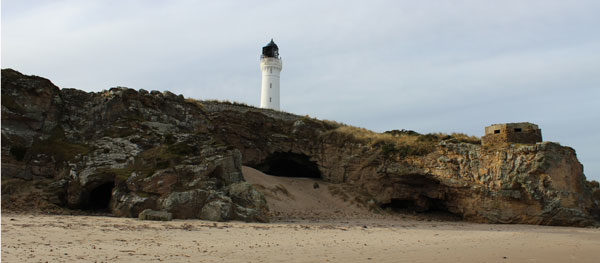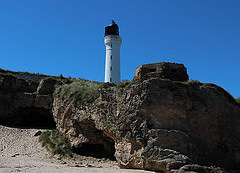Environment
Covesea Skerries Lighthouse sits on Craighead, a rocky headland half way along Lossiemouth’s West Beach; which runs from Covesea Village in the west to Lossiemouth in the east, a distance of some 3 miles.
The sandstone ridge, which runs behind the beach to the west, was laid down some 250 million years ago in desert conditions. Closer to the lighthouse sand dunes back the beach, covered with marram grass and areas of dense stands of spreading whin (gorse).Behind the dunes is the Laich of Moray (an area of low lying land).

Below the lighthouse caves tunnel back into the rock. Other caves, found along the coast towards Hopeman, have Pictish symbols carved on their walls. Others are linked to stories of smugglers using them to take their booty as far as Lossiemouth, Gordonstoun and even Elgin! The caves were used until the last century by travelling people . A family called the 'Joyfuls', because of their habit of singing hymns in the streets, lived in the caves below the lighthouse until the 1920s.
On the coast remains of WW2 wartime defences can still be spotted. Along the beach toward Lossiemouth a line of tank traps jut out of the sand and set on the cliffs below the lighthouse there is the remains of a gun emplacement 'pillbox'.
Looking across the Moray Firth on a clear day the Sutherland and Caithness mountains can be clearly seen. Tarbat Ness lighthouse is also visible (at night flashing white 4 times every 30 seconds); it was built in response to the terrible storm in 1826 which resulted in Covesea Skerries Lighthouse being built on this coast some 15 years later.
The coastline and the Moray Firth support a wide range of species and habitats. At low tide grey and common seals can be seen basking on the Halliman and Covesea Skerries, the rocky outcrops lying just off the headland. Moray Firth also has its own resident population of bottlenose dolphins, one of only three in the UK. These can be seen in the Firth, along with the occasional minke whale, harbour porpoise and basking shark.
Primroses, red campion and dog violets cover some areas in spring alongside the explosion of colour and wonderful smell of the yellow gorse make spring a particularly colourful time.
In addition, the Firth is famous for the large and internationally famous populations of migratory wildfowl and waders which pass through. Listen for stonechats, linnets, willow warblers, and out at sea fulmers, herring gulls, cormorants and oyster catchers can be seen. Peregrine falcons have used the lighthouse as a nesting site; add to this sparrowhawks, osprey and spectacular diving gannets, the coast is an ornithological treasure! One of our volunteers was even been lucky enough to see a little egret!



